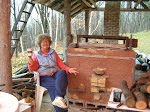In the evening we sat around the campfire and traded stories
of canoe trips and art experiences. We
also discussed Wally Schaber’s book on the Dumoine, “The Last of the Wild
Rivers” and how important the River was to First Nations people as a north/south
highway.
The Indian Point Pot
I had brought clay for everyone to make a pot the way the
aboriginal people made them here thousands of years ago as evidenced by the “Indian
Point Pot”. Radiocarbon dated at 2500 years BP (before present), it was
excavated during an archaeological dig at Indian Point across from Deep River
in the early 1950’s and is now on display at the Museum of Civilization in
Ottawa. One evening we sat around the fire, surrounded by the dark forest and
silence, channeling spirits from the past. We coiled the clay into a beehive
shape that was then turned over and pinched, paddled and scraped into a thin
open vase. It could have been an evening thousands of years ago, our hands repeating
the same motions made millennia ago and resulting in pots very similar to the
Indian Point Pot – with a flared lip and a rounded bottom to better withstand
the thermal shock of cooking over open fires.
Eva Gallagher (center) demonstrates how First Nations first made pottery in this area thousands of years ago. Photo credit Scott Haig 2017.
I came back from the camp energized, ready to continue working on several
pieces that I had started at the camp. In October CPAWS hosted a very
successful gala and silent auction of the donated art in Gatineau at “The Moore
Farm”, a National Capitol Region restored post and beam barn that is open to hosting
various events. With featured guests, singer/songwriter Ian Tamblyn,
artist/environmentalist Robert Bateman, the event raised over $11,000 for the
Dumoine River project."
The idea of an art camp - that idea of bringing together
artists to work on a common theme are becoming more popular and I highly recommentd this type of experience . Hopefully CPAWS is going
to offer another Dumoine Art Camp in August 2019 so in interested look to apply early in the spring.of 2019.














